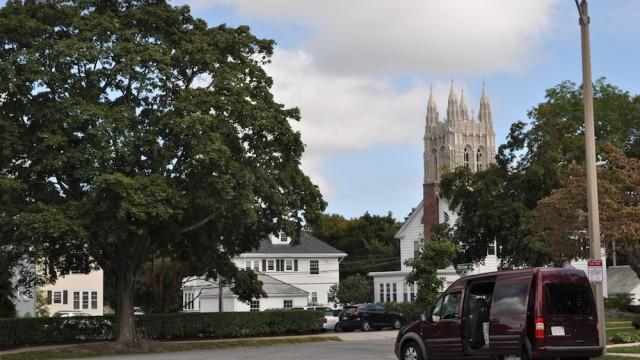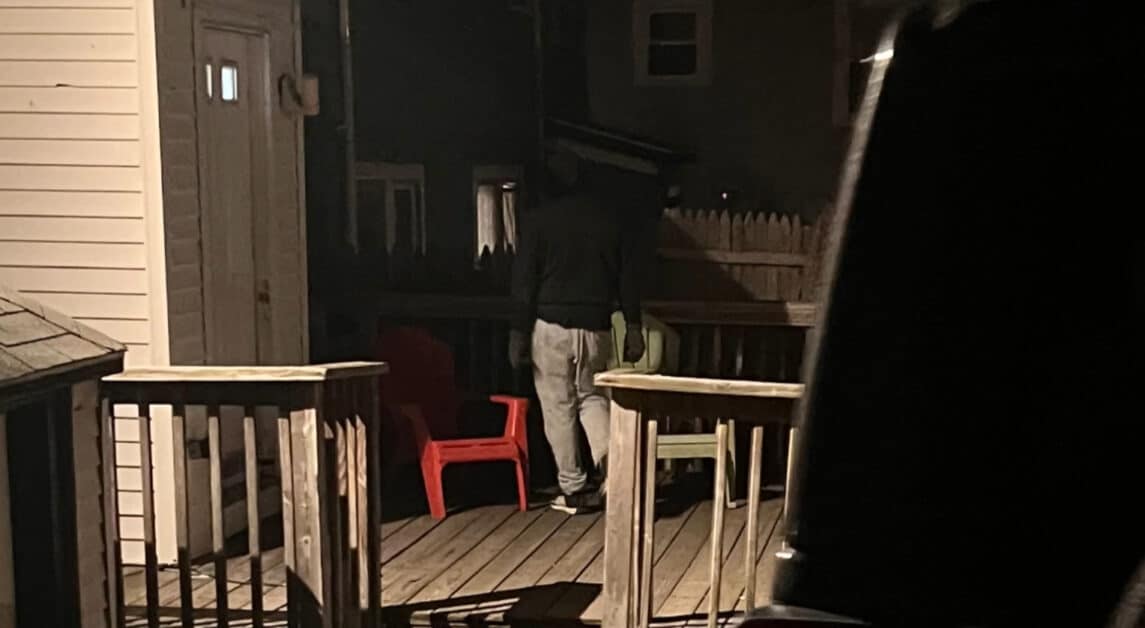Editor’s Note: This story is part of an ongoing series about off-campus housing at BC.
With just a few days left in September, students are reasonably expected to be fully immersed in their classes, clubs, and jobs—and most are. But, like every year, there’s a group of about 1,200 students in the sophomore class who are already thinking about next fall. They’re next year’s crop of tenants, who will fill houses on off-campus roads like Gerald, Foster, and Kirkwood, and they’re already signing leases.
“We literally looked and signed our lease within three days of the first week of school,” said Brielle Mariucci, A&S ’17, who, along with a group of friends, secured a house on the much-coveted Gerald Road.
Sara Barrett, A&S ’17, signed a lease early last week for a house on Gerald, too. She and 10 other friends rushed to sign to make sure they got the duplex that, according to their realtor, many other groups were interested in.
There is a belief among sophomores going off campus for their junior year that all the best houses are swept up before the end of September, and—whether that’s the case or not—some groups don’t want to take a chance on missing out.
“I tell students, don’t rush it, because everyone gets housing. It’s not like anyone’s going to be on the streets.”
“Obviously, you don’t want to end up not having a place to live,” Barrett said. “But who knows if that’s actually the case—whether [the houses] all go now or not.”
It’s difficult to tell, especially for students who have little knowledge of the supply and demand in the local market. According to George Arey, associate vice president of Student Affairs for Residential Life, at any given time, between 1,200 and 1,300 students live off campus. There’s no definitive way to tell how many and when houses are available without relying on realtors’ knowledge, but according to Peter Kwiatek, assistant director for off-campus housing, students who enter the game late usually don’t have any trouble finding a place to live.
“I tell students, don’t rush it, because everyone gets housing,” he said. “It’s not like anyone’s going to be on the streets. We’re putting people in housing throughout the year.”
As much as ResLife wishes it could persuade students to proceed with caution while searching for off-campus housing, as soon as one group signs a lease, others feel pressure to do the same, and once the frenzy starts, there’s no stopping it.
Peers aren’t the only ones contributing to the pressure. Realtors have every incentive to sign houses quickly—they earn a fee equal to one month’s rent at the time of signing. Because the Boston market has a high demand, landlords don’t pay this realtor fee, as some do in other markets. Rather, it’s passed along to the leasers. Students—first-time renters who are unfamiliar with the market—often are shocked when they hear they’ll have to pull together the cash to cover the realtor fee.
“We were kind of just blindsided by those once we already put our money down,” Barrett said of the realtor fee and the security deposit, a fee paid to the landlord at the time of signing that’s returned at the end of the lease as long as the tenants don’t damage the property.
At the time of signing, most agencies and landlords require leasers to submit the first month’s rent and the realtor fee. Last month’s rent and the security deposit (equal to one month’s rent) are typically required soon after.
According to ResLife, the average rent in Brighton ranges from $1,200 for a studio apartment to over $4,000 for properties with more than four bedrooms. Thus, four students renting an average priced four-bedroom apartment are often required to come up with four times one month’s rent in order to cover all the fees associated with signing, and this is before any financial aid for that year is dispersed to their student accounts.
Students on financial aid continue to receive support from the University while they live off-campus, but the amount of money they are awarded typically decreases because the “cost of attendance is lower for a student living off campus,” according to the Financial Aid section of BC’s website. Room and board for students living on campus is generally higher than rent costs for students in off-campus homes and apartments, due to a “value-added” component of the cost for on-campus residence halls. The University charges more for the benefits of convenience and access to residence halls’ common spaces, among other things, according to Arey.
While most students welcome a lower cost as one of the perks of living off campus for a year, Hee Leem, A&S ’15, believes that his off-campus housing experience is costing him more than living on campus would. A transfer student, Leem was slow to make living arrangements for this year due to the fact that at the beginning of last year, while most students were figuring out where they would live off campus, Leem was just settling in at BC, and was far from knowing who he would want to live with a year later.
This is a familiar situation for transfer students, all of whom are granted only one year of housing, no matter when they transfer. Some scramble and sign leases with people they barely know. Many others appeal for an extra year of housing.
Leem did appeal, but was denied. So in March of last year, by which time his non-transfer friends had largely figured out their housing and his transfer friends had either done the same or had had their appeals granted, Leem began looking for a home for this year.
“I was trying to find somewhere close enough—walking distance or at least close to a bus stop—but unfortunately those are pretty high demand, so they’re gone,” Leem said. In the end, he leased an apartment in 2000 Commonwealth Ave. with another transfer student. 2000 is one of the most expensive options for off-campus accommodations, and for fear of it filling up before they were able to move in, Leem and his roommate paid for the apartment starting in August even though they would not be living there until September.
Leem said he felt as if he received little help from the University throughout the process and was disappointed by the recalculation of his financial aid, which he said did not take into account the cost of furnishing a new apartment. Coming from California, he could not bring his own furniture and had to purchase it all here—further driving up a cost which, by his calculations, matches or even exceeds that of living on campus.
Kristen Gallant, A&S ’15, also a transfer student, feels that the housing policy for transfers is unfair and even illogical.
“I think that transfer students already feel ostracized as it is and forcing them to live off campus (away from the senior social scene, especially) makes us feel left out,” Gallant wrote in an email. “Transfer students are allowed to be transfers because there are openings in the class they transfer into. This means someone with four or three years of housing are no longer attending BC. Where do these years of housing go?”
Gallant is currently living off campus as a senior, and while she is pleased with her living situation overall, she agreed with Leem that an already difficult situation is made even harder for transfer students who, faced by pressure from realtors and peers, rush to sign leases for homes they know little about with people they have just met, potentially facing costs unanticipated.
The issue of hidden costs is not unique to transfer students, however. Barrett, who used Great Places Realty, didn’t recall her agent ever outlining the additional fees associated with signing. Mariucci, who used Greenline Realty, said her agent was “very helpful” in explaining the fees before signing the lease, but said the agent made it clear that in order to get a good house, she and her friends would have to sign as quickly as possible.
“You had maybe like a day [to decide] because there were rumors that if you didn’t sign the lease, the next day someone else is going to have the house,” she said.
This combined pressure from peers and realtors that gives way to rushed signings often leaves students vulnerable, and often, responsible for fees they never anticipated, Kwiatek said.
He tells students who are uncomfortable about realtors rushing them into a lease to seek another agency. Years ago, ResLife published a list of preferred realtors, alongside one warning against specific agencies. In response to threatened legal action from realtors, however, the University removed the lists and now lists area agencies who ask to be listed, removing those with whom students having bad experiences report.
“Students are often being taken advantage of, they often don’t know what their rights are or don’t feel empowered to utilize those rights.”
Some, like Mariucci and Barrett, believe the University should do more to connect students with resources about the off-campus process.
“I feel like the only promotion [about realtor companies] was from other students and other students who lived off-campus who could help us, but I don’t think there was much help from the school,” said Mariucci, who relied on her friend’s brother to connect her group to a realtor.
Another tenet of the off-campus process that students have cited as confusing is the city’s “No More Than Four” ordinance, which forbids more than four undergraduates from living together in the same unit. The city has historically not enforced the law, but with the ushering in of Mayor Martin J. Walsh, WCAS ’09’s administration has come an increase in its enforcement.
Barrett learned about the rule from a Res. Life email, and she recalls her realtor mentioning it as she was looking for housing. The agent told her group that to comply with the law, they couldn’t have more than four people on the lease. ResLife doesn’t condone breaking the ordinance, but Kwiatek acknowledges the reality of the situation and students’ tendency to disregard the law.
“The city is definitely much more aware of all the violations, and we just tell students that we don’t recommend putting yourselves in that situation because we don’t want to see anything happen to you,” he said.
But the reality—especially on streets close to campus like Gerald and Kirkwood—involves large homes with more than four bedrooms and monthly rents that are well above $4,000. Considering all the fees associated with signing a lease, in addition to the costs for utilities, furniture, and groceries, many students choose not to follow the law.
Kwiatek—who is just a month into his job as assistant director for off-campus housing—said his main goal for the year is to be more visible and to better promote the resources that ResLife offers to off-campus students.
One of those resources, a series of comprehensive information sessions about the off-campus housing process, was completely revamped this year. Four sessions covering topics ranging from lease fees to neighborhood life were held over the past two weeks, together drawing over 150 students—far more than have attended similar sessions in past years.
Kwiatek also hopes to use technology to better convey information about off-campus housing. Within the next few weeks, ResLife will unveil a new interactive website that will serve as a central hub for listings, property photos, and a roommate finder exclusively composed of BC students.
“We definitely understand the market of off-campus housing … students are often being taken advantage of, they often don’t know what their rights are or don’t feel empowered to utilize those rights,” Kwiatek said.
He hopes these new initiatives will go a long way in empowering students to understand the process, recognize their rights, and know what’s expected of them.
Special Projects Editor Mary Rose Fissinger contributed to this article.
Featured Image by Emily Fahey / Heights Editor



















